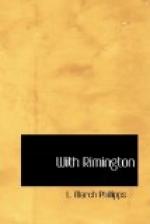You would scarcely think it was the scene of a battle, and yet there are a few signs. If you look along the trees and bushes, you see here and there a bough splintered or a whole trunk shattered, as though it had been struck by lightning. A little lower down the river there is a shed of corrugated iron, which looks as if some one had been trying to turn it into a pepper-pot by punching it all over with small holes. They run a score to the square foot, and are a mark of attention on the part of our guards, who, lying down over yonder in the plain, could plainly distinguish the light-coloured building and made a target of it. In many places the ground is ploughed up in a curious way, and all about in the dust lie oblong cylinders of metal, steel tubes with a brass band round one end. These would puzzle you. They are empty shell cases. The tops, as you see, have been blown off, which is done by the bursting charge timed by a fuse to ignite at a certain range, i.e., above and a little short of the object aimed at. The explosion of the bursting charge by the recoil, checks for an instant the flight of the shell, and this instant’s check has the effect of releasing the bullets with which the case is filled. These fly forward with the original motion and impetus of the shell itself, spreading as they go. Horizontal fire is easy to find cover against, but these discharges from on high are much more difficult to evade. For instance, ant-hills are excellent cover against rifles, but none at all against these shells. It is shrapnel, as this kind of shell is called, that does the most mischief. The round bullets (200 to a caseful) lie scattered about in the dust, and mixed with them are very different little slender silvery missiles, quite pretty and delicate, like jewellers’ ornaments. These are Lee-Metford bullets. You could pick up a pocketful in a short time.
The action itself was mainly an infantry one. Here are one or two jottings taken that day:—
“November 26th, 7.30 A.M.—We left camp, six miles south of Modder River, a little before daylight and marched north. The country is like what one imagines a North American prairie to be, a sea of whitish, coarse grass, with here and there a low clump of bushes (behind one of which we are halted as I write this). One can see a vast distance over the surface. Along the north horizon there is a ripple of small hills and kopjes, looking blue, with the white grass-land running up to them. It is a comparatively cool morning with a few light clouds in the sky and a pleasant breeze. On our left is the railway, and all along on our right, extending far in front and far behind, advances the army.”




